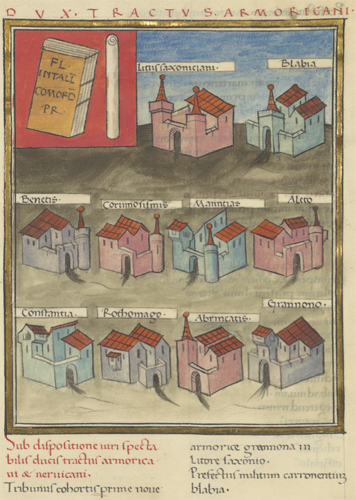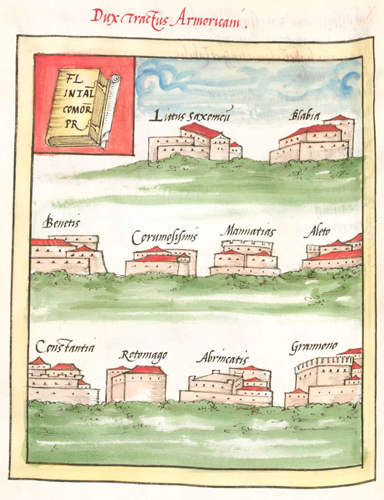
This page created 27 December 2002, and last modified: 7 February 2015 (four more frontpiece illustrations added)

 Above: Frontpiece from the Bodleian manuscript (O). The stations depicted are: Litus Saxoniciani, Blabia, Benetis, Corumosismis, Mannatias, Aleto, Constantia, Rotomago, Abrincatis, Granono. |
The following tribunes and prefects along with their units are listed as being under the command of the Duke of the Armorican and Nervican Tract (the numbers in front of the names refer to Ingo Maier's numbering scheme):
151.2 Tribunus cohortis primae novae Armoricanae, at Grannona in litore Saxonio |
 Above: Frontpiece from the Munich manuscript (W). In contrast to the contemporary (i.e. 15th-century) Italianate appearance of the Bodleian frontpiece, that from (W) is believed to be closer to the lost Codex Spirensis version, at least in style, despite W's later (mid-16th century) date. |
Note the spelling of 'Armoricani' in the Bodleian frontpiece illustration shown above left. That such an obvious mistake occurs in such a bold headline setting does not inspire confidence in the absolute accuracy in the spelling of the various names given in the rest of the document! This appears even worse when one considers B is generally regarded as having a reasonably low amount of scribal errors compared to e.g. P, the Parisian manuscript. Also note that Osismiacorum Osismis in entry 151.5 is actually given as osismis corumosismis in the manuscripts.
It is plain that many of the units listed above are the same as many of the pseudocomitatenses units of the Gallic field army commanded by the Magister Equitum and drawn from the troops said to be under the control of the Magister Peditum. For example, as the Praefectus militum prima Flavia is stationed in Constantia (modern Coutances), he obviously commands the Prima Flavia Gallicana Constantia. Similarly, the Praefectus militum Maurorum Osismiacorum listed above obviously commands the Mauri Osismiaci listed as being under the Magister Equitum's command in Gallia. Likewise the Praefectus militum superventorum at Mannatias (modern Nantes) would appear to command the Superventores iuniores, and similarly, the Praefectus militum Martenium at Aleto (modern Aleth near Saint Malo) would appear to command the Martenses. Thus the Notitia Dignitaum is here recording a state of affairs that no longer applied when the section recording the Gallic field army was written.
Further, the Praefectus militum Ursariesium at Rotomagus (modern Rouen) would appear to command the Ursarienses, even though they are listed as a comitatenses unit in the Gallic field army rather than a pseudocomitatenses unit. This would indicate they were drafted into the field army earlier than the other units. Jones thought they were equivelent to the Praefectus militum Ursariensium under the Dux Raetiae primae et secundae, but the Armorican troops would appear to be an even more suitable candidate to my mind: a gravestone from Amiens (CIL 13.3492) belonging to an IMAG[i]N(ifer) N(umeri) URSARIEN(sium) surely refers to this unit: Amiens being just 100 kilometres from Rotomago (moderns Rouen) as the crow flies.
The Magister Equitum also commands many units of pseudocomitatenses that are not listed as being drawn from those under command of the Magister Peditum. It appears that many of these are drawn from the region's limitanei commanders such as the Dux Mogontiacensis and also the Dux Armorica. For instance, the otherwise unknown Abrincateni would appear to be the men commanded by the Praefectus militum Dalmatarum, since he is stationed in Abrincatis (modern Avranches). The otherwise unknown Garronenses seem to be the men commanded by the Praefectus militum Grannonenium stationed in 'Grannono', with a variant spelling; this is reinforced by the appearence of the Praefectus militum Carronentium in the same list (but stationed at Blabia, perhaps modern Hennebont); as well as the Tribunus cohortis primae novae Armoricanae who is listed as being stationed in "Grannona in litore Saxonio". All these three officers seem to command detachments of men belonging to the same unit, called the Garronenses, although where Grannona is in modern France is yet unknown (it is possible there may hve been more than one location with such a name; after all, there is also a Gariannonor mentioned under the Comes litoris Saxonici per Britanniam, who commanded the Praepositus equitum stablesianorum Gariannonensium, stationed at Gariannonor, and which is usually equated with Burgh Castle in Norfolk, England).
As the Praefectus militum Maurorum Osismiacorum is listed as being stationed in Osismiacum it his clear that his unit name simply means the 'Moors in Osismiacum' (i.e. in modern Brest); the Praefectus militum Maurorum Benetorum, being stationed in Benetis likewise means the 'Moors in Benetis' (modern Vannes). It would seem that these are most likely two detachments of the same unit, which is listed simply as the Mauri Osismiaci in the lists of the Magistri Peditum and Equitum.
The following relationships can thus be identified between the Armorican officers and the Gallic field army:
Tribunus cohortis primae novae Armoricanae formerly commanded part of the Garronenses Praefectus militum Carronensium formerly commanded part of the Garronenses Praefectus militum Maurorum Benetorum formerly commanded part of the Mauri Osismiaci Praefectus militum Maurorum Osismiacorum formerly commanded part of the Mauri Osismiaci Praefectus militum superventorum formerly commanded the Superventores iuniores Praefectus militum Martentium formerly commanded part of the Martenses Praefectus militum prima Flavia formerly commanded the Prima Flavia Gallicana Constantia Praefectus militum Ursarientium formerly commanded the Ursarienses Praefectus militum Dalmatarum formerly commanded the Abrincateni Praefectus militum Grannonentium formerly commanded part of the Garronenses
The following shield patterns can therefore be taken from those given under the Magister Peditum.

Those under O come from the Bodleian manuscript in Oxford, those under P from the Paris manuscript, those under M from the first portion of the Munich manuscript, those under W from the second portion of the Munich manuscript, and those under B from the Froben edition. The pattern for the Garronenses is not given in the Notitia, unless it is one of the units that is otherwise shown under a different name, but for which no matching entry can be found. Note that these are unlikely to have been the patterns born by the units still under the Dux, however, as units transferred to a field army from a garrison station seem to have been given new shield patterns.
As the removal of what appears to be every single detachment of the Armorican limitanei force would have left the area entirely denuded of its garrison, it is not hard to see why the area so rapidly left Roman control; according to Zosimus (6.5.3), it managed to expel its Roman officials and replace them with a home-grown administration in 409 (note that van Berchem, 'Some Chapters of the "Notitia Dignitatum"', 1995, available here, would have the Armorican units, such as the men of the Praefectus militum Martensium, being detachments of the Gallic field army, rather than vice versa).
This impression of loss of control is reinforced by the observation that although the Tract is listed (85/6.45) in the Notitia as being one of twelve commands in the west that has an associated Duke (Dux), the Duke himself is not in the list (98/9.9 ff) of Dukes coming under the control of the Magister Peditum (the Dux Provinciae Sequanici is also absent from this list). This is further evidence that the command had effectively ceased to exist at some point over the working lifetime of the western half of the Notitia (ca. 395 - 425), with some, but not all, of the entries connected with it being deleted. Note that the command of the Armorican and Nervican Tract does not correspond geographically to any of the civilian provinces of Gaul, and as such, there is no single corresponding civilian officer to the Duke. The Tract apparently partially overlapped with the civilian provinces of 85/6.113 Lugdunensis secunda and 85/6.114 Lugdunensis tertia, each under the command of a President (praeses); and with 85/6.74 Belgica secunda and 85/6.72 Germania secunda, each under the command of a Consul (consularis). All four of these officers reported to the Vicar (vicarius) of the Diocese of the Seven Provinces, who was himself subordinate to the Praetorian Prefect of the Gauls.
Below are shown the frontpieces from the Parisian manuscript, P (including in this case some of the following text); the Froben printed edition, B; and the first set of pictures in the Munich manuscript, M:




Return to the Notitia index page.